Bracing 4 front teeth is a suitable solution for individuals whose front teeth are slightly gapped, mildly misaligned, or improperly erupted but do not affect the entire arch. This method helps improve aesthetics and chewing function without requiring full-arch intervention. Many choose this option to save time and treatment costs.
How much does it cost to brace 4 front teeth?
The average cost for bracing 4 front teeth ranges from 5,000,000 to 15,000,000 VND, depending on the type of braces, the degree of tooth misalignment, and the dental clinic.
Detailed pricing for bracing 4 front teeth by brace type
| Appliance Type | Estimated Price (VND) |
| Metal Braces | 5,000,000 – 7,000,000 |
| Ceramic Braces | 7,000,000 – 10,000,000 |
| Self-ligating Braces | 9,000,000 – 12,000,000 |
| Invisalign Mini Braces | 12,000,000 – 15,000,000 |
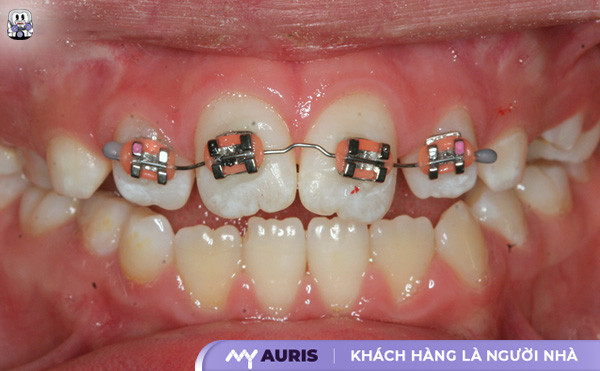
Factors affecting the cost of bracing 4 front teeth
The cost of braces is not fixed; it depends on various factors. Understanding these factors will help you proactively plan a suitable and cost-effective treatment:
- Type of braces you choose
The cost varies depending on the type of appliance used. Traditional metal braces are the least expensive, suitable for those who prioritize effectiveness over aesthetics. If you opt for ceramic braces or clear aligners like Invisalign, the cost will be significantly higher.
- Degree of front teeth misalignment
Front teeth can be gapped, slightly misaligned, or severely tilted to one side. The more complex the misalignment, the more detailed the treatment plan and the more advanced orthodontic technology required. This increases the cost of bracing 4 front teeth. In many cases, the dentist will need to combine additional techniques such as using mini-screws, special archwires, or specialized appliances.
- Orthodontic technique applied
Partial braces for front teeth often involve techniques such as accelerated orthodontics, aesthetic braces, or combined restoration. Some people might opt for porcelain veneers instead of orthodontics, but this is not an ideal method if the bite is misaligned. Proper orthodontic treatment will help preserve chewing function and avoid long-term negative effects.
- Orthodontist’s expertise and accompanying technology
A highly qualified orthodontist will accurately assess the dental condition and propose a suitable solution. The use of 3D imaging machines, bite simulation software, or high-tech archwires all affect the cost. A reputable dental clinic typically invests thoroughly in its team and equipment, which comes with a higher price but ensures stable and safe treatment results.
- Geographic location and reputation of the dental clinic
In Ho Chi Minh City or Hanoi, the cost of bracing 4 front teeth may be higher compared to smaller provinces and cities. The more established and highly-rated a dental clinic is for its treatment results, the higher the cost may be above average, but you will have greater peace of mind regarding the safety and durability of the orthodontic outcome.
- Incidental costs during treatment
Some cases require additional interventions such as scaling, treating gingivitis, or cleaning before braces are placed, which also affects the total cost. If aesthetic dental restoration, porcelain veneers, or cosmetic fillings are needed after braces are removed, these are also expenses to consider before starting.
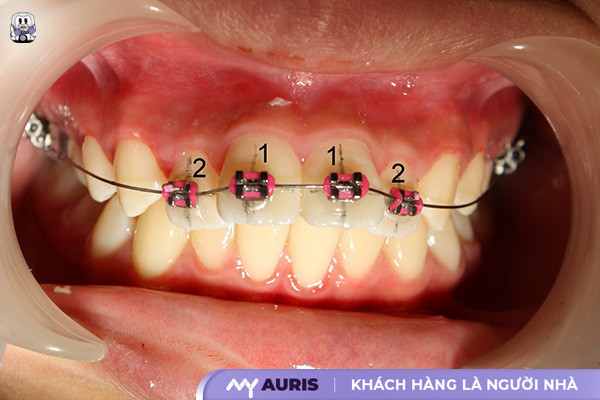
Should you only brace 4 front teeth?
Bracing 4 front teeth is a form of partial orthodontics, focusing on the front teeth – typically the upper or lower incisors. This method is usually applied in cases where front teeth are gapped, slightly misaligned, and do not significantly affect the bite.
Unlike full-arch braces, this technique only affects the front teeth area, thereby saving treatment costs, bracing time, and providing aesthetic benefits in the visible area.
If clear aligners like Invisalign mini are used, users will have a comfortable, highly aesthetic, and easily removable experience. In some cases, non-bracket archwires or clear aligners for just 4 teeth may be prescribed to simplify the process.
Not every case is suitable for bracing just 4 front teeth. Here’s a specific guide:
You should brace 4 front teeth when:
- Front teeth are mildly gapped, slightly misaligned, and do not affect the bite.
- There is still space in the dental arch, no tooth extraction is required.
- Adults seeking aesthetic orthodontics to quickly improve their appearance.
- There’s a need for aesthetic improvement in the front teeth area, but full-arch treatment is not feasible.
You should NOT brace 4 front teeth when:
- Front teeth are severely misaligned, the upper jaw is deviated, or the bite is already incorrect.
- Adjacent teeth are also misaligned, affecting the overall bite.
- There is an indication for tooth extraction or full-arch adjustment.
- Young individuals under 14 years old, whose jawbones have not yet developed stably.
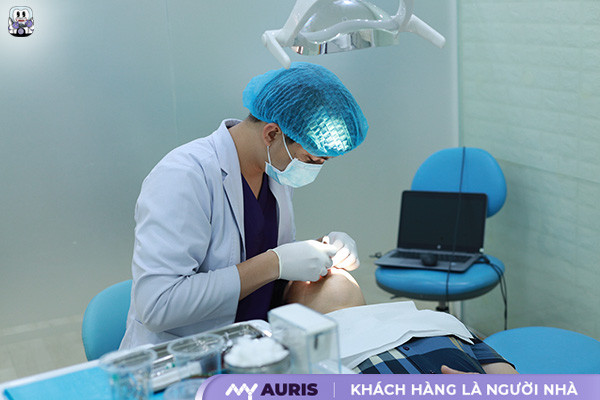
How is the 4 front teeth bracing process carried out?
However, to ensure long-term effectiveness, you need to understand the implementation process and follow each step as directed by the orthodontist:
Examination and 3D dental X-ray
The dentist conducts a comprehensive examination, evaluating the condition of gapped front teeth, misaligned front teeth, bite, and the stability of the remaining teeth. X-rays help determine whether partial braces are feasible or if full-arch intervention is necessary.
Developing a personalized treatment plan
Based on the examination results, the dentist will propose a specific treatment plan:
- Whether tooth extraction is necessary
- Using metal braces, ceramic braces, or clear aligners like Invisalign mini
- Estimated treatment duration
This step is crucial for the future effectiveness and aesthetics.
Attaching braces to the 4 front teeth that need correction
Depending on the chosen appliance, the dentist will bond braces to the front teeth and secure them with specialized archwires. With the Invisalign method, you will receive custom-designed clear aligners to change every 2–3 weeks. Typically, full-arch braces are not needed, but sometimes additional supporting screws or linking wires are required to ensure correct tooth movement direction.
Regular monitoring and adjustments
Every 3–6 weeks, you need to revisit the dental clinic for the dentist to adjust the archwires, change aligners (if using Invisalign), and check the degree of tooth movement. This process typically lasts from 3 to 8 months, depending on the extent of tooth misalignment and the patient’s age.
Braces removal and retainer wear
Once the teeth are properly aligned, the dentist will remove the braces and attach a fixed or removable retainer to prevent the teeth from shifting back. This stage is mandatory for long-term results, especially for the upper front teeth, which are easily affected by biting forces and daily habits.
Notes for bracing 4 front teeth to achieve good results
Thorough preparation before deciding on front teeth bracing
A thorough examination and X-rays are necessary to determine the extent of tooth misalignment and bite issues. Research different types of braces (metal, ceramic, Invisalign) to fit your budget and agree on a treatment plan with a reputable orthodontist to avoid affecting the jaw and temporomandibular joint.
Proper oral hygiene throughout the bracing process
Thorough oral hygiene is crucial. Brush your teeth at least twice a day with a specialized toothbrush, use dental floss and a water flosser for deep cleaning around the braces. Rinse with salt water or alcohol-free mouthwash after each meal to reduce plaque and tooth decay.
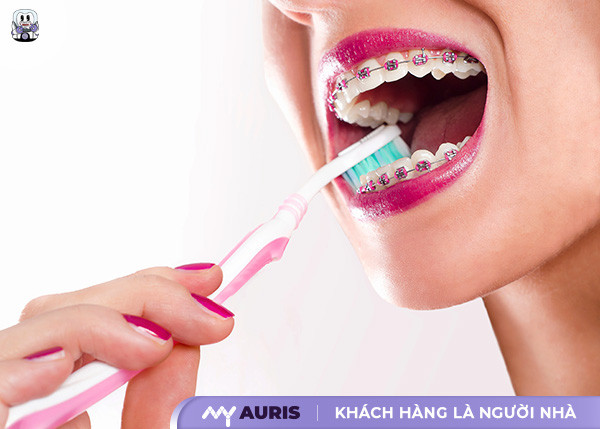
Dietary restrictions and adjusting daily eating habits
To prevent braces from detaching and archwires from bending, avoid overly hard foods (bones, taffy), overly sticky foods (sticky rice cakes), and limit sugary carbonated drinks and colored foods. During the first two weeks, consume soft foods like porridge and soup to allow your teeth to adapt to the pressure.
Adhere to follow-up appointments and control orthodontic forces
The treatment duration for bracing 4 front teeth is typically shorter (3-8 months). You need to attend follow-up appointments on schedule for the dentist to adjust the tightening force. Do not attempt to remove appliances yourself. Always monitor the movement of your front teeth to prevent misalignment or imbalance. Patient commitment is crucial for good results.
Wear retainers diligently after braces removal
Even with partial braces, wearing a retainer (fixed or removable) is mandatory to prevent teeth from shifting back to their original positions, especially for the front teeth. Non-compliance carries a very high risk of front teeth relapsing.
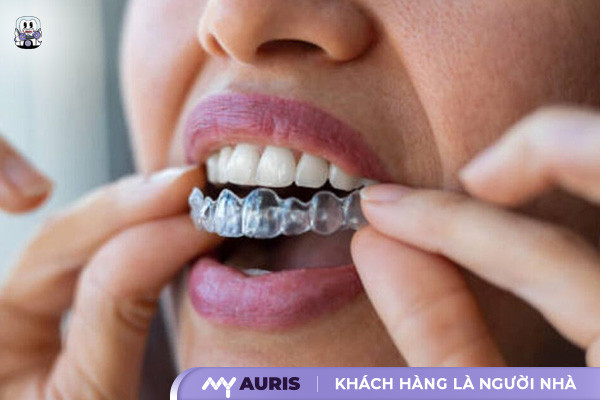
Prioritize reputable dental clinics and orthodontists specializing in partial orthodontics
Choose a licensed dental clinic specializing in dentofacial orthopedics, with an orthodontist who has graduated from a specialized program and holds an orthodontic certificate. The treatment process should be clear, and costs transparent. Choosing the right dentist ensures aesthetic results and long-term bite function.
Related Questions
Below are frequently asked questions related to individual front teeth bracing, helping you make the right decision and save costs.
Do gapped 2 front teeth need braces?
If the gap is larger than 1–2mm or if the teeth tend to flare outwards, the orthodontist will usually prescribe specialized orthodontic appliances such as braces or clear aligners to bring the teeth together along the correct axis. Without intervention using braces or an archwire system, tooth movement can easily become misdirected, leading to an incorrect bite.
Some alternative solutions like veneers or cosmetic fillings are only suitable when the gap is very small and adjacent teeth have balanced shapes. However, these methods do not address the root cause and can affect tooth structure in the long run.
How long does it take to brace upper front teeth?
The treatment duration for bracing upper front teeth is often much shorter than for full-arch braces. In cases where 2–4 front teeth are gapped, mildly misaligned, or have a slight deep bite, the average treatment time ranges from 4 to 8 months, depending on the degree of misalignment and the method used.
If you choose partial braces with metal brackets, the appliance placement will focus only on the front teeth, using light force archwires to move the teeth. Effectiveness is usually visible after the first 2–3 months, but to maintain and stabilize the bite, you will still need to wear a retainer after the appliance is removed.
Should you brace individual front teeth?
In cases where front teeth are slightly misaligned and do not affect the overall bite, you can absolutely opt for partial braces or bracing 2–4 front teeth to save costs. This is an effective solution, especially if you only want to improve the visible portion of your teeth when smiling.
However, if the front teeth are misaligned due to an overall bite problem (e.g., deep bite, crossbite), correcting only a few teeth will not be sustainable and may lead to complications after braces removal. In such cases, the dentist will recommend full-arch treatment to ensure long-term stability.





